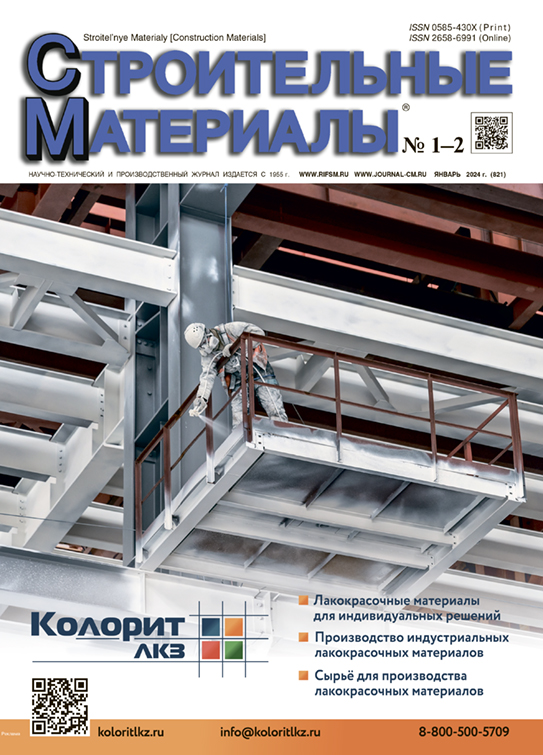Application of Blast Furnace Granulated Slag for Self-Healing Bio-Concretes
- Autores: Chernykh T.N.1, Gorbachevskikh K.A.1, Komelkova M.V.1, Platkovskiy P.O.1, Kriushin M.V.1, Orlov A.A.1
-
Afiliações:
- South Ural State University (National Research University)
- Edição: Nº 1-2 (2024)
- Páginas: 42-48
- Seção: Modern concretes
- URL: https://rjeid.com/0585-430X/article/view/635959
- DOI: https://doi.org/10.31659/0585-430X-2024-821-1-2-42-48
- ID: 635959
Citar
Texto integral
Resumo
The properties of fine-grained concrete containing 20–80% granulated blast furnace slag and bacteria species Bacillus Subtilis have been studied. An assessment was made of changes in strength, self-healing of cracks using optical and electron microscopy and measuring the speed of ultrasound propagation perpendicular to the crack plane; composition and characteristics of the healing agent in cracks using X-ray analysis methods. Self-healing of cracks in concrete without bacteria occurred due to calcite deposition as a result of carbonation of portlandite during 50–65 cycles of humidification-drying, and in the presence of Bacillus Subtilis bacteria due to calcite deposition during their vital activity in 10–15 cycles. It is shown that the addition of granulated blast furnace slag slows down the crystallization of calcite, which forms a healing substance in the crack. It is assumed that the combined use of granulated blast furnace slag in dosages of 40–80% and Bacillus Subtilis bacteria in concrete structures operating under conditions of variable humidification can ensure the process of self-healing cracks and maintaining the strength of concrete in the long term due to simultaneous processes of strengthening the structure due to prolonged hydration of slag minerals and calcite deposition in cracks due to the vital activity of Bacillus Subtilis bacteria.
Texto integral
Sobre autores
T. Chernykh
South Ural State University (National Research University)
Autor responsável pela correspondência
Email: chernykhtn@susu.ru
Doctor of Sciences
Rússia, ChelyabinskK. Gorbachevskikh
South Ural State University (National Research University)
Email: kirill38964@gmail.com
Student
Rússia, ChelyabinskM. Komelkova
South Ural State University (National Research University)
Email: komelkovamv@susu.ru
Doctor of Sciences (Biology)
Rússia, ChelyabinskP. Platkovskiy
South Ural State University (National Research University)
Email: paw.platkovski@yandex.ru
Research Assistant
Rússia, ChelyabinskM. Kriushin
South Ural State University (National Research University)
Email: kriushinmv@susu.ru
Engineer
Rússia, ChelyabinskA. Orlov
South Ural State University (National Research University)
Email: orlovaa@susu.ru
Candidate of Sciences (Engineering)
Rússia, ChelyabinskBibliografia
- Karpov M.V., Zhizdyuk A.A., Naumova O.V. Justification of the use of bio concrete for the construction of hydraulic structures. Vestnik evraziyskoynauki. 2022. Vol. 14. No. 5. Article 10. (In Russian).
- Il’ina L.V., Tacki L.N., D’yakova K.S. Self-healing concrete. review of foreign publications. Vestnik ESSUTM. 2023. No. 2 (89), pp. 72–79. (In Russian). doi: 10.53980/24131997_2023_2_72
- Jonkers H.M. Bacteria-based self-healing concrete. Heron. 2011. Vol. 56. No. 1/2.
- Biryukov V.S., Smirnov A.S., Tambovcev A.M., Cherednichenko T.F. Trends in modern construction: self-healing concrete. Inzhenernyy vestnik Dona. 2022. No. 2 (86), pp. 1–8. (In Russian).
- Liu Y., Zhuge Y., Fan W., Duan W., Wang L. Recycling industrial wastes into self-healing concrete: A review. Environmental Research. 2022. Vol. 214. Part 4. 113975. doi: 10.1016/j.envres.2022.113975
- González Á., Parraguez A., Corvalán L., Correa N., Castro J., Stuckrath C., González M. Evaluation of Portland and Pozzolanic cement on the self-healing of mortars with calcium lactate and bacteria. Construction and Building Materials. 2020. Vol. 257. 119558. doi: 10.1016/j.conbuildmat.2020.119558
- Khushnood R.A., Qureshi Z.A., Shaheen N., Ali S. Bio-mineralized self-healing recycled aggregate concrete for sustainable infrastructure. Science of The Total Environment. 2020. Vol. 703. 135007. https://doi.org/10.1016/j.scitotenv.2019
- Nodehi M., Ozbakkaloglu T., Gholampour A. A systematic review of bacteria-based self-healing concrete: Biomineralization, mechanical, and durability properties. Journal of Building Engineering. 2022. Vol. 49. 104038. https://doi.org/10.1016/j.jobe.2022.104038
- Strokova V.V., Vlasov D.Yu., Frank-Kamenet- skaya O.V., Dukhanina U.N., Balitsky D.A. Applica- tion of microbial carbonate biomineralization in biotechnologies of building materials creation and restoration: analysis of the state and prospects of development. Stroitel’nye Materialy [Construction Materials]. 2019. No. 9, pp. 83–103. (In Russian). DOI: https://doi.org/10.31659/0585-430X-2019-774-9-83-103
- Bazhenov Yu.M., Erofeev V.T., Salman A.D.S.D., Smirnov V.F., Fomichev V.T. Tekhnologiya samovosstanovleniya zhelezobetonnyh konstrukcij s pomoshch’yu mikroorganizmov. Russkiy inzhener. 2018. No. 4 (61), pp. 46–48. (In Russian).
- De Belie N., Gruyaert E., Al-Tabbaa A., Antonaci P., Baera C., Bajare D., Jonkers H.M. A Review of self-healing concrete for damage management of structures. Advanced Materials Interfaces. 2018. Vol. 5. Iss. 17 1800074. doi: 10.1002/admi.201800074
- De Rooij M., Van Tittelboom K., De Belie N., Schlangen E. Self-healing phenomena in cement-based materials: State-of-the-art report of RILEM technical committee 221-SHC: Self-healing phenomena in cement-based materials Springer. Dordrecht, Netherlands. 2013. 266 p.
- Van Tittelboom K., De Belie N. Self-healing in cementitious materials – A review. Materials. 2013. Vol. 6 (6), pp. 2182–2217. doi: 10.3390/ma6062182
- Zhang L.V., Suleiman A.R., Allaf M.M., Marani A., Tuyan M., Nehdi M.L. Crack self-healing in alkali-activated slag composites incorporating immobilized bacteria. Construction and Building Materials. 2022. Vol. 326. Article 126842. doi: 10.1016/j.conbuildmat.2022.126842
- Siddique R., Singh K., Singh M., Corinaldesi V., Rajor A. Properties of bacterial rice husk ash concrete. Construction and Building Materials. 2016. Vol. 121, pp. 112–119. https://doi.org/10.1016/j.conbuildmat.2016.05.146
- Aquilano D., Benages R., Bruno M., Rubbo M., Massaro F.R. Positive {hk.l} and negative {hk.} forms of calcite (CaCO3) crystal. New open questions from the evaluation of their surface energies. CrystEngComm. 2013. Vol. 15 (22), pp. 4465–4472. doi: 10.1039/C3CE40203G
Arquivos suplementares














